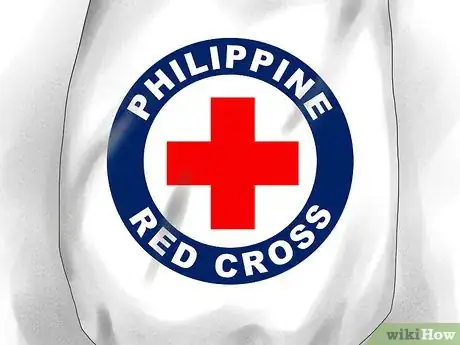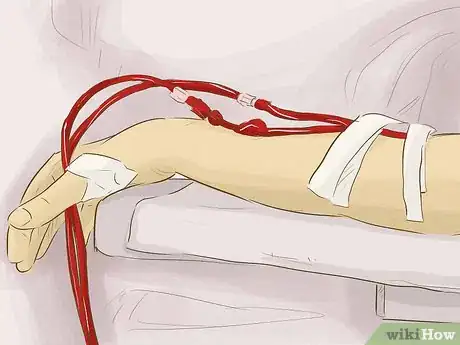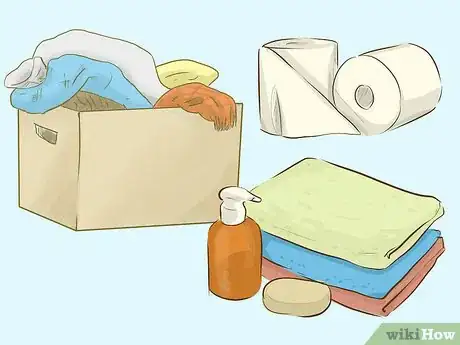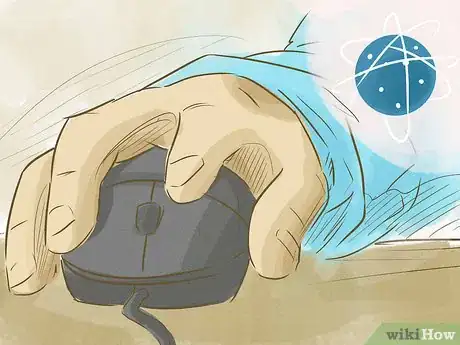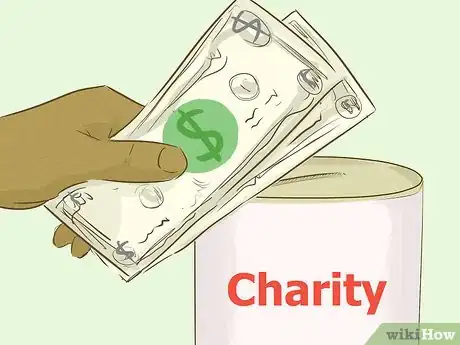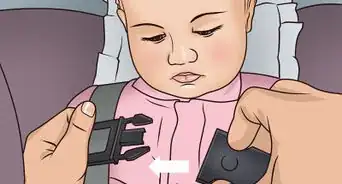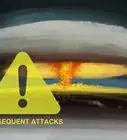This article was co-authored by Direct Relief. Direct Relief is an award-winning humanitarian aid organization, active in all 50 states and more than 80 countries. They focus on helping people affected by emergencies and natural disasters. Direct Relief has been highly rated by Charity Navigator, GuideStar, and the Center for High Impact Philanthropy at University of Pennsylvania, for their effectiveness, efficiency, and transparency.
There are 8 references cited in this article, which can be found at the bottom of the page.
This article has been viewed 24,513 times.
When you hear that a powerful hurricane has hit land, caused flooding, and put people in danger, you may wish there was some way that you could help. Hurricane Ida, one of the latest powerful hurricanes to make landfall, has left hundreds of thousands without power and caused significant damage and flooding. After a devastating storm like Hurricane Ida, there are many different ways you can help people who were impacted. Donating money is usually the most needed form of help. There are many organizations and charities that you can choose from, and several different ways that you can make your donation. You can also volunteer your time or donate a particular service to help hurricane victims.
Steps
Donating Money
-
1Visit the organization’s or charity’s website. Most organizations and charities make donating easy and clear on their websites. Visit the website of the charity or organization that you want to donate to, look at the menu for the word “donate,” click on it, and then continue to click and fill out information as you’re prompted to do so.
- When big natural disasters take place, it’s likely that the donations given to these relief-focused nonprofit organizations will go towards helping victims. If you want to be sure of this, look on the website for a mention of the specific natural disaster.
- Fill out your preferred donation amount and credit card or PayPal information to donate to All Hands Volunteers.
- Go to https://www.habitat.org/impact/our-work/disaster-response to donate to Habitat for Humanity’s disaster relief fund.
- Pay attention to how much the donation fees are when donating to a nonprofit's website. Some nonprofits will ask that you cover the standard donation fee, so that all of the money can go to the organization.
-
2Call or text to donate. Many charities and organizations have phone numbers that are easy to remember so that you can pick up the phone, dial the number, and follow the automated menu in order to donate money. Often when hurricanes devastate an area, organizations, like the Red Cross, will set up a phone number and message that you can text to make a quick, easy donation.
- For example, donate to Salvation Army by calling 1-800-SAL-ARMY.
- It is wise to inquire about texting fees, as they can be much higher than normal text message rates.
- You can typically find these phone numbers on the website of the organization or charity that you’re donating to.
Advertisement -
3Donate through Facebook. Facebook makes donating easy just after a major natural disaster has taken place. Sign in, look for the “Explore” heading, click on “Fundraisers,” click “Crisis Relief,” and then scroll through the different options and click “Donate” once you’ve found the one you want to donate to. This should take you to a page where you can select the amount you’d like to donate and fill out payment information.
- You can also “share” your donation so that others may see that you donated and want to donate as well.
-
4Donate through iTunes. Apple has come up with an easy way for you to donate money to hurricane relief, as long as you have an iTunes account. If necessary, put money into your iTunes account, and then sign in and click the “Donate” button underneath the amount you’d like to donate. This will transfer 100% of the amount you selected from your iTunes account to the Red Cross.[1]
- This may only be an option immediately following a natural disaster. Apple typically provides this donation opportunity temporarily in response to a particular disaster that has devastated an area.
-
5Make a donation on a GoFundMe page. While it’s a little bit riskier than donating to a big organization, you can donate to individuals affected by the hurricane and learn about their personal experiences on https://www.gofundme.com. Type the name of the hurricane into the search bar at the top of the page, scroll through the many different fundraisers, click on the one you want, and then click the “Donate Now” button. Then, enter in the desired amount and your payment information.[2]
- You can also “share” your donation on social media to show others how they can help.
- GoFundMe staffers claim that donations go directly to beneficiaries, and not to any middle men, in order to ensure that the money gets to the right person or people.
- Very rarely, people lie about the causes they create pages for. In most of these instances, GoFundMe staffers will recognize a campaign as “intentionally misleading” and reimburse all donations.[3]
Donating Goods and Services
-
1Offer housing through Airbnb. If you’re near the area that was hit by the hurricane and you have a rental property or even just an extra room in your home, offer the space up through Airbnb. Sign up your home or rental property for disaster relief by clicking “Sign up your home,” clicking “Get started,” and logging into your account. Then, proceed to go through each guided step and fill out information regarding the space you want to provide.[4]
-
2Donate blood. When major disasters happen, an unpredictable number of people in the same area get injured and are hospitalized. Because of this, the hospitals run low on blood supply and desperately need more. By contacting the Red Cross or another similar organization, you can get your blood drawn and potentially save a life.[5]
- On the day you’ll be donating, make sure to dress comfortably, drink plenty of water, and eat iron-rich foods, such as spinach and red meat. Don’t forget to bring a photo ID and a list of medications that you’re currently taking.
- When you go to donate blood, you’ll first go through registration, answer questions about your health history, and receive a mini-physical exam. A needle will then be inserted into your arm and you’ll sit comfortably for about 10 minutes while about 1 pint (0.5 Liters) of your blood is drawn.[6]
- You need to be healthy, weigh at least 110 pounds, and be at least 16 or 17 years old in most states to donate blood.
-
3Stay away from the affected areas. After natural disasters, many who have good intentions flock to the area in an attempt to provide help. However, this can create even more chaos and confusion. If possible, stay away from the affected area immediately after the hurricane hits. This will help minimize traffic for emergency vehicles so that first responders can focus on getting immediate help to those who are hurt and in danger.[7]
-
4Spread the word on social media. Staying active on social media can be a life or death situation immediately following a bad hurricane. Many post on sites like Twitter with their addresses and names, begging for help. Check your social media feeds frequently and “share” or “retweet” these kinds of posts to help those individuals.
- If the situation is serious and dangerous, call 9-1-1 to inform an emergency operator about it so that the individuals in need get help as soon as possible.
- Resist the urge to go help them yourself. This could put you in a dangerous situation and/or create more chaos for first responders.
-
5Sign up to volunteer. If you’re interested in volunteering your time and labor, then the best thing you can do is sign up or register to do so, and then wait to be contacted. You can usually sign up to volunteer through Americorps, Habitat for Humanity, and many others.[8]
- While this kind of help is extremely beneficial, it’s not normally needed right after disaster strikes. The initial priority is transporting people to safety and giving medical attention to those in need. Later on, volunteers are needed to help repair damage.
- To find out how to register, go to: https://www.nvoad.org/howtohelp/volunteer/.
-
6Send needed supplies. After a powerful hurricane hits, the government will often launch a relief guide that includes specific supplies that are needed. These supplies typically include things like bottled water, hand sanitizer, tarps, and extension cords. Once a guide like this is launched online, donate whichever items you want to in order to help.[9]
- To find one of these guides, try typing the country where the hurricane hit followed by “government relief guide” into a search engine online.
- You can also find these kinds of supply lists through major organizations.
- Don’t send supplies that aren’t on a specified list, or else they may end up unused and stored somewhere with other excess supplies that volunteers and first responders didn’t have the time to open up and sort through.
Choosing Who to Donate to
-
1Look for accreditation before you donate. Donating money is the easiest, fastest, and often most desirable way that you can help hurricane victims. While there are numerous small and large reputable organizations and charities that you can donate to, some aren’t legitimate. Always check ratings of the group, organization, or charity and make sure they’re accredited before you send them money.[10]
- Use http://www.charitynavigator.org to see if the group, organization, or charity you want to donate to is legitimate.[11]
-
2Make a donation to a national or global organization. There are many large scale organizations that help with disasters everywhere. Some of these include the Red Cross, Habitat for Humanity, All Hands Volunteers, and many more. Go with any large organization that has 4 stars on http://www.charitynavigator.org.[12]
- Donate specifically to helping children through Save the Children or United Nations Children's Fund (UNICEF), or specifically to animals through American Society for the Prevention of Cruelty to Animals (ASPCA).[13]
- If you want to make sure that your donation will go towards helping the victims of a specific hurricane, look on the organization’s website for any information about the hurricane.
-
3Give to a local charity. After a hurricane has hit a particular area, local charities will advertise that they’re helping in recovery efforts. You should also consider giving to local food banks, animal shelters, diaper banks, or nonprofit health centers. While these types of organizations might not consider themselves disaster relief organizations, they almost always end up playing a critical role in the recovery efforts.[14]
- For example, when Hurricane Maria hit Puerto Rico and the surrounding islands, charities like Unidos por Puerto Rico and Fund for the Virgin Islands took donations in order to help with relief.
- You can also check with your own local churches and community centers for donation drives and fundraisers going toward hurricane relief.
References
- ↑ https://www.fastcompany.com/40465819/hurricane-irma-relief-14-ways-to-help-storm-victims-from-volunteer-florida-to-airbnb
- ↑ https://www.nytimes.com/2017/09/08/us/hurricane-irma-help-donate.html
- ↑ http://www.cnn.com/2017/04/17/us/iyw-gofundme-accounts-legitimate-how-to-trnd/index.html
- ↑ https://www.accuweather.com/en/weather-news/how-to-help-donate-to-assist-hurricane-harvey-irma-victims/70002574
- ↑ https://www.accuweather.com/en/weather-news/how-to-help-donate-to-assist-hurricane-harvey-irma-victims/70002574
- ↑ http://www.redcrossblood.org/donating-blood/donation-process#t2
- ↑ https://www.accuweather.com/en/weather-news/how-to-help-donate-to-assist-hurricane-harvey-irma-victims/70002574
- ↑ https://www.fastcompany.com/40465819/hurricane-irma-relief-14-ways-to-help-storm-victims-from-volunteer-florida-to-airbnb
- ↑ http://www.pbs.org/newshour/rundown/can-help-hurricane-victims-puerto-rico/
- ↑ https://www.nytimes.com/2017/09/08/us/hurricane-irma-help-donate.html
- ↑ https://www.nytimes.com/2017/09/22/world/americas/hurricane-maria-donate-charity.html
- ↑ https://www.nytimes.com/2017/09/22/world/americas/hurricane-maria-donate-charity.html
- ↑ https://weather.com/storms/hurricane/news/how-you-can-help-maria-victims
- ↑ https://www.nytimes.com/2017/09/22/world/americas/hurricane-maria-donate-charity.html



